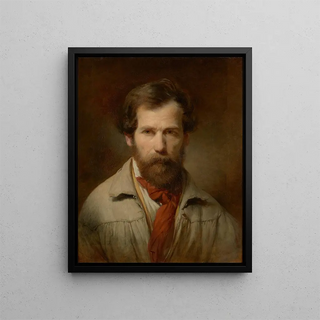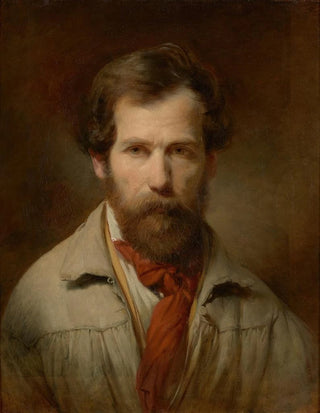Art print | Self-portrait - Friedrich von Amerling


View from behind

Frame (optional)
Friedrich von Amerling's Self-Portrait is an iconic artwork that embodies both the artist's technical mastery and the psychological depth of its subject. Created in the 19th century, this painting is much more than a simple self-representation; it is an intimate exploration of identity and the human condition. The canvas, with its subtle lighting and refined details, invites the viewer to delve into the artist's inner world. This masterpiece, which has stood the test of time, continues to evoke curiosity and admiration, testament to the richness of art history and artists' ability to communicate emotions through their work.
Style and uniqueness of the work
Friedrich von Amerling's self-portrait stands out for its academic style and meticulous attention to detail. The artist employs a delicate color palette, where flesh tones blend with darker shades, creating a contrast that emphasizes the depth of his gaze. The composition is carefully crafted, highlighting the artist's face, whose pensive and introspective expression captivates the viewer. Amerling manages to convey a sense of serenity while revealing a certain melancholy. The elegant clothing and carefully chosen accessories add an extra dimension to the piece, underscoring both the artist's status and his sensitivity to the fashion of his time. Every brushstroke, every detail, reflects exceptional craftsmanship and a desire to capture the very essence of the human being.
The artist and his influence
Friedrich von Amerling, born in 1803 in Vienna, is one of the most representative artists of the Austrian Romantic movement. His training with the great masters of the era and his travels across Europe shaped his unique style, blending realism and idealization. Amerling succeeded in establishing himself in the art world through his portraits, which are often considered windows into the soul of his subjects. His influence extends beyond his time, inspiring generations of artists who sought to capture the complexity of human emotions. Through his work, he contributed

Matte finish

View from behind

Frame (optional)
Friedrich von Amerling's Self-Portrait is an iconic artwork that embodies both the artist's technical mastery and the psychological depth of its subject. Created in the 19th century, this painting is much more than a simple self-representation; it is an intimate exploration of identity and the human condition. The canvas, with its subtle lighting and refined details, invites the viewer to delve into the artist's inner world. This masterpiece, which has stood the test of time, continues to evoke curiosity and admiration, testament to the richness of art history and artists' ability to communicate emotions through their work.
Style and uniqueness of the work
Friedrich von Amerling's self-portrait stands out for its academic style and meticulous attention to detail. The artist employs a delicate color palette, where flesh tones blend with darker shades, creating a contrast that emphasizes the depth of his gaze. The composition is carefully crafted, highlighting the artist's face, whose pensive and introspective expression captivates the viewer. Amerling manages to convey a sense of serenity while revealing a certain melancholy. The elegant clothing and carefully chosen accessories add an extra dimension to the piece, underscoring both the artist's status and his sensitivity to the fashion of his time. Every brushstroke, every detail, reflects exceptional craftsmanship and a desire to capture the very essence of the human being.
The artist and his influence
Friedrich von Amerling, born in 1803 in Vienna, is one of the most representative artists of the Austrian Romantic movement. His training with the great masters of the era and his travels across Europe shaped his unique style, blending realism and idealization. Amerling succeeded in establishing himself in the art world through his portraits, which are often considered windows into the soul of his subjects. His influence extends beyond his time, inspiring generations of artists who sought to capture the complexity of human emotions. Through his work, he contributed






